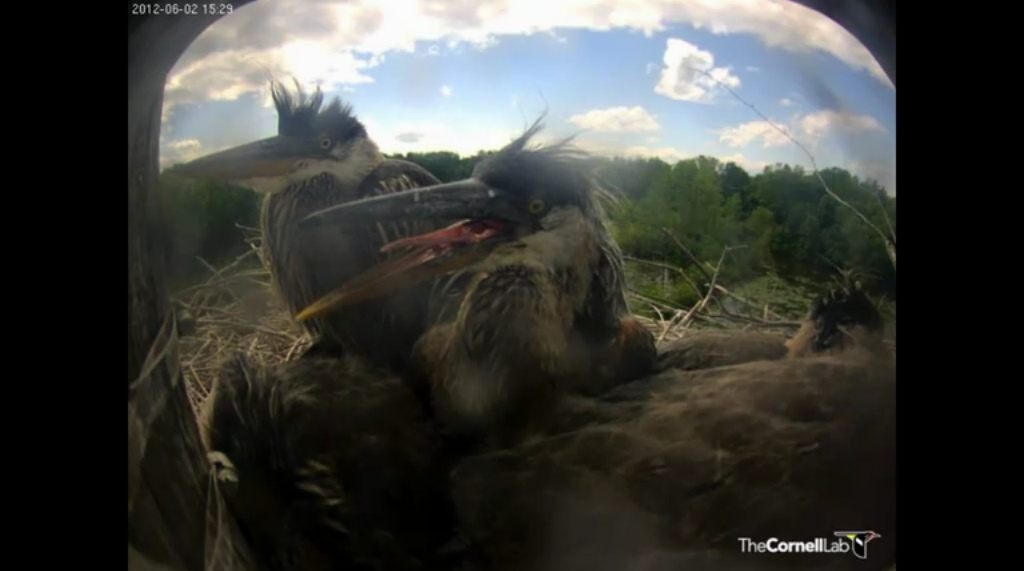A Twitter That Really Tweets, And Other Uses For 7,500 Hours Of Animal Sounds

Chopin and Einstein, two great blue herons donating their sights and sounds to science through a Cornell Lab birdcam. (Photo: Keri Leaman/Flickr)
It’s counterintuitive, but the last thing you expect to see on Twitter is an actual bird. That is, unless you follow an account called Animal Video Bot. Every few hours, this nature-loving program tweets clips randomly pulled from the Cornell Lab of Ornithology’s Macauley Library, the world’s largest collection of animal audio and video. Scroll past one, and it autoplays, filling your ears with trills and rustles, and your eyes with flaps, hops, and colorful plumage.
Sighting a Thayer’s Gull or a Northern Saw-Whet Owl in the thickets of a feed that’s otherwise all news and snark is both surprising and refreshing. Indeed, AnimalVidBot creator Darius Kazemi says his friends call his culture-and nature-related projects “earnest bots.”

Using Animal Video Bot, and similar projects like Ed Summers’s Macauley Library Mix, which provides a continuous stream of wild sounds you can combine to “build your own ecosystem,” feels like looking through the wrong end of the binoculars, dilating the flat, myopic Internet world so that it better encompasses the big, textured, real one.
Ornate Fruit-Dove Ptilinopus ornatus Laman, Timothy G. http://t.co/IKiP9ZaKsq pic.twitter.com/V1OdL4WDBt
— Animal Video Bot (@AnimalVidBot) August 12, 2015
Of course, none of this would be possible if not for an Internet database—specifically, the Macauley Library. The Cornell Lab of Ornithology’s massive collection of natural sights and sounds clocks in at 7,513 hours of tape, and contains recordings that date back to 1929. It generally caters to ornithologists, hobbyist birders, and others seeking niche knowledge, prepping for field work, or studying up for the next Audio Quiz.
But after full digitization was achieved in 2013, leaving all of these tweets, grunts, and strange percussive screams only a click away, people have been putting them to use in surprising ways.

Listening to this black-capped chickadee could help us figure out why we talk the way we do. (Photo: GollyGforce/Flickr)
For one thing, there’s a lot of cross-disciplinary scientific action. Human speech experts, for example, love to eavesdrop on bird brains, library curator Greg Bundney told Cornellcast in 2011. While some birds are born with instinctive singing chops, chickadees, robins, and other common species learn their songs from each other—a neural process that highly resembles human speech development, and can provide rich insight into how babies start to talk. And word nerds since Darwin have thought that bird lexicons might also teach us how human speech evolved.
Other scientists use animal sounds to look out at evolution instead of in. For years, library director Mike Webster has been taping Black-throated Blue Warblers, trying to figure out how they switch up their migration strategies to better deal with climate change. Anthropologist Jonathan D. Amith has been using the noises to help complete a lexicon of pre-Hispanic Mexican natural history, playing calls for contemporary Nahuatl speakers and writing down what the Aztecs would have called each creature.
A billboard that yells at birds in their own language. (Image/Recording: Steve Pokin/Springfield News-Leader)
But there’s a lot going on outside the lab. At some point, a clever human realized it was possible to use our recorded animal dictionary to effectively talk to animals—particularly to tell them to get out of places where we don’t want them. Ever since, property owners have made their trespassing policies known by broadcasting them in the feathery interlopers’ own languages. Stand under this billboard in the Missouri Ozarks, for example, and you’ll be treated to a mashup of distress calls and scary predatory screeches, thanks to an installable unit called the Bird-B-Gone. (“It keeps them from roosting in there and pooping, basically,” Steve Raper, the general manager of the billboard, explained to the Springfield News-Leader.)
Others use the library to draw people in. Just as smelling cut grass or soaking in sunshine can rocket you back to your childhood backyard, hearing the natural soundtrack of a place pulls you into it immediately, even if that soundtrack is coming through your speaker cabinet. In his book Feral, George Monbiot quotes a forester friend, Ritchie Tassell, who “can seldom watch a television drama” because they’re always soundtracked by birds from the wrong continent (“they’re obsessive about the setting, the period costumes, the hair, the vehicles, the horses, but they always get the birdsong wrong,” Tassell says). The Macauley Library can, and has, been used to buck this trend, providing sounds for everything from museum exhibits to Ken Burns documentaries and Pixar films.

A Cornell Lab “experimental terrestrial realtime acoustic detection” unit, which can identify bird and elephant calls. (Photo: Matt MacGillivray/Flickr)
Its real animals have also helped to bring fictional ones to life—the magical coos of Fawkes, the phoenix from Harry Potter, are made from a cocktail of Macauley-recorded noises, and the Jurassic Park dinos were basically voiced by a whole zoo. In this way, the library’s recorded snippets can give voice to entire landscapes—or underline those landscapes’ fragility, as in “What Is Missing,” a project by the artist Maya Lin that uses sounds and videos to memorialize the dwindling species that may, someday, exist only on screens.
At the moment, most of us exist largely in front of screens ourselves—a fact which also screeches for artistic disruption. Luckily, the Macauley Library can help with those, too. When asked why people enjoy the Twitter account of @AnimalVidBot, Kazemi cites not its content or its color, but the very fact of its existence: “It’s just a nice reminder that there are other things in the world besides the Internet.”
One of the weirder audiovisual experiences available, digitized by the Macauley Library.
Naturecultures is a weekly column that explores the changing relationships between humanity and wilder things. Have something you want covered (or uncovered)? Send tips to cara@atlasobscura.com.

















Follow us on Twitter to get the latest on the world's hidden wonders.
Like us on Facebook to get the latest on the world's hidden wonders.
Follow us on Twitter Like us on Facebook